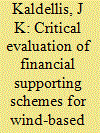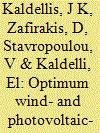|
|
|
Sort Order |
|
|
|
Items / Page
|
|
|
|
|
|
|
| Srl | Item |
| 1 |
ID:
104912


|
|
|
|
|
| Publication |
2011.
|
| Summary/Abstract |
After a long stagnating period during the second half of the 1990s, the market of wind energy in Greece was described by remarkable but unstable growth rates that resulted in the operation of 1 GW of wind power by the end of 2009. Still though, penetration of wind energy is not the one anticipated. On the other hand, national targets regarding the Renewable Energy Sources' (RES) contribution and existence of excellent wind potential areas across Greece challenge new wind energy investments. Acknowledging the unsteady development rates of wind power in Greece, efficiency of the State support mechanisms is currently investigated. Based on an analytical evaluation model, the investigation undertaken is extended to provide a detailed cost-benefit analysis of several wind energy case studies, including mainland and island applications as well as comparison with both conventional power stations and photovoltaic plants. For this purpose, the financial support provided by the State is directly compared with benefits accruing from the operation of wind parks, considering also the avoidance of social costs deriving from thermal power stations. Based on the results obtained, the beneficial characteristics of wind energy applications for the Greek society are clearly demonstrated, especially in the case of non-interconnected island grids.
|
|
|
|
|
|
|
|
|
|
|
|
|
|
|
|
| 2 |
ID:
111405


|
|
|
|
|
| Publication |
2012.
|
| Summary/Abstract |
Renewable energy sources (RES) based stand-alone systems employing either wind or solar power and energy storage comprise a reliable energy alternative, on top of conventional diesel-electric generator sets, commonly used by remote consumers. However, such systems usually imply the need for oversizing and considerable energy storage requirements leading to relatively high costs. On the other hand, hybrid configurations that may exploit both wind and solar potential of a given area may considerably reduce energy storage capacity and improve the economic performance of the system. In this context, an integrated techno-economic methodology for the evaluation of hybrid wind-photovoltaic stand-alone power systems is currently developed, aiming at the designation of optimum configurations for a typical remote consumer, using economic performance criteria. For the problem investigation, the developed evaluation model is applied to four representative areas of the Greek territory with different wind potential characteristics in order to obtain optimum configurations on the basis of minimum initial investment, 10-year and 20-year total cost. According to the results obtained, the proposed solution is favorably compared with all other stand-alone energy alternatives, reflecting the ability of hybrid systems to adjust even in areas where the local RES potential is not necessarily of high quality.
|
|
|
|
|
|
|
|
|
|
|
|
|
|
|
|
| 3 |
ID:
104915


|
|
|
|
|
| Publication |
2011.
|
| Summary/Abstract |
In the case of the telecommunication (T/C) services' expansion to rural and remote areas, the market generally responds with the minimum investments required. Considering the existing situation, cost-effective operation of the T/C infrastructure installed in these regions (i.e. remote T/C stations) becomes critical. However, since in most cases grid-connection is not feasible, the up-to-now electrification solution for remote T/C stations is based on the operation of costly, oil consuming and heavy polluting diesel engines. Instead, the use of photovoltaic (PV)-based hybrid power stations is currently examined, using as a case study a representative remote T/C station of the Greek territory. In this context, the present study is concentrated on the detailed cost-benefit analysis of the proposed solution. More precisely, the main part of the analysis is devoted to develop a complete electricity production cost model, accordingly applied for numerous oil consumption and service period scenarios. Note that in all cases examined, zero load rejections is a prerequisite while minimum long-term cost solutions designated are favorably compared with the diesel-only solution. Finally, a sensitivity analysis, demonstrating the impact of the main economic parameters on the energy production cost of optimum sized PV-diesel hybrid power stations, is also provided.
|
|
|
|
|
|
|
|
|
|
|
|
|
|
|
|
| 4 |
ID:
116720


|
|
|
|
|
| Publication |
2012.
|
| Summary/Abstract |
The main aim of the specific research is the comparison of the energy pay-back period of optimum renewable energy sources (RES)-based configurations, meaning wind-battery and photovoltaic-battery stand-alone installations that may ensure the energy autonomy of a typical remote consumer under the condition of minimum life cycle (LC) energy content. In this context, energy autonomy is first ensured on the basis of an appropriate sizing methodology, while accordingly, by developing a calculation algorithm for the estimation of the LC energy content of such energy autonomous systems, minimum LC embodied energy configurations are eventually obtained. On top of that, three representative areas are examined so as to investigate the influence of the local wind and solar potential. According to the results, the sustainable character of both RES-based solutions is designated, especially when comparison with the conventional diesel-engine solution is carried out. On the other hand, the situation is inversed when comparing stand-alone and grid-connected RES systems of the same size, with significant contribution of the battery storage component being reflected.
|
|
|
|
|
|
|
|
|
|
|
|
|
|
|
|
| 5 |
ID:
111398


|
|
|
|
|
| Publication |
2012.
|
| Summary/Abstract |
Large-scale integration of Renewable Energy Sources (RES) applications is thought to be imperative for Greece in view of meeting the targets of 2020, which dictate that 20% of the national gross energy consumption and 40% of the national gross electricity consumption should be covered by RES. However, availability of suitable sites for the installation of such applications is questioned, since apart from the fact that many locations of high RES potential and adequate infrastructure have already been allocated, the society opposition often sets additional barriers. The present study focuses on the assessment of the levels of social acceptability for selected RES technologies (wind, small hydro and photovoltaics) in a representative region of Southern Greece. The specific area is of major interest since, apart from the operating and scheduled installations of RES applications in the next years, the local population is also familiar with the long-term operation of a lignite-based power station (850 MW). One three-part questionnaire has been deployed for conducting the survey based on a representative sample of local inhabitants. According to the results obtained, high levels of acceptability of renewable energy applications have been encountered although the need for additional public information regarding RES exploitation has also been designated.
|
|
|
|
|
|
|
|
|
|
|
|
|
|
|
|
| 6 |
ID:
117314


|
|
|
|
|
| Publication |
2013.
|
| Summary/Abstract |
To date, most of the existing wind farms have been built on-land but during the last few years many countries have also invested in offshore applications. The shift towards offshore wind project developments has mainly been driven by European energy policies, especially in north-west countries. In offshore sites the winds are stronger and steadier than on-land, making wind farms more productive with higher capacity factors. On the other hand, although offshore wind energy is not in its infancy period, most of the costs associated with its development are still much higher from onshore counterparts; however some recent technological progress may have the potential to narrow this gap in the years to come. In the present work, an overview of the activity noted in the field of offshore wind energy is carried out, with emphasis being given on the current status and future trends of the technology employed, examining at the same time energy production and availability issues as well as economic considerations.
|
|
|
|
|
|
|
|
|
|
|
|
|
|
|
|
|
|
|
|
|